 |
|
FireDrones
A feasible, timely, scalable
system
to mitigate wildfires.
A trillion trees sequester CO2 with a FireDrone umbrella.
|
Stop a fire while it's still small.
|
Save forests, lives, homes, wildlife and the planet too. |
An idea whose time has come.
|
|
|
|
|
| 1 |
|
|
Imagine: A wildfire has just begun in Cascade Forest.
|
A NASA satellite pinpoints the location, while alerting FireDrone Base Delta 9, situated on the US/Canadian border, the closest base to the fire. NASA
The fire's position is precisely calibrated to within 100 meters. Satellites deliver crystal-clear realtime imagery.
Team staff review the incoming data, cross-check with other sources, and confirm that a fire has broken out within their jurisdiction.
|
|
|
|
Computer models suggest 375 FireDrones
will do the job.
|
All-Weather, Day or Night, water-filled FireDrones power up and launch into the sky within minutes of the alert.
Though the fire is located 60 miles from the base in a remote and roadless area, at 180 MPH they will punctually arrive on scene in a brief 20 minutes — ready to battle the fire.
In order to alert all low-flying traffic on the route, FireDrones will be flying in neat formations, flashing red and green lights, and continuously broadcasting their location. |
|
|
|
Base personnel continuously monitor the flight...
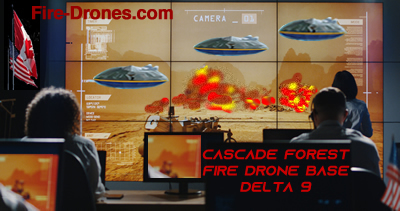
Cascade Forest Fire Drone Base Delta 9 |
...and they will have their eyes wide open.
This cutting edge technology will always be mediated by experienced and dedicated professionals.
High-resolution cameras and a variety of sensors aboard the armada will report conditions from any angle as the mission draws closer.
Course and altitude corrections will be constantly refining their flight. Because FireDrones can fly through or hover in hot dense smoke and still report ground conditions, guidance and attack parameters will be constantly coordinated and updated for maximum benefit.
|
|
|
|
This fire would have spread wildly out of control..

"From a Spark to Raging Fury." • Vitaliia Kalmutska - Project Artist
...were it not for the timely arrival of the FireDrone Fleet!
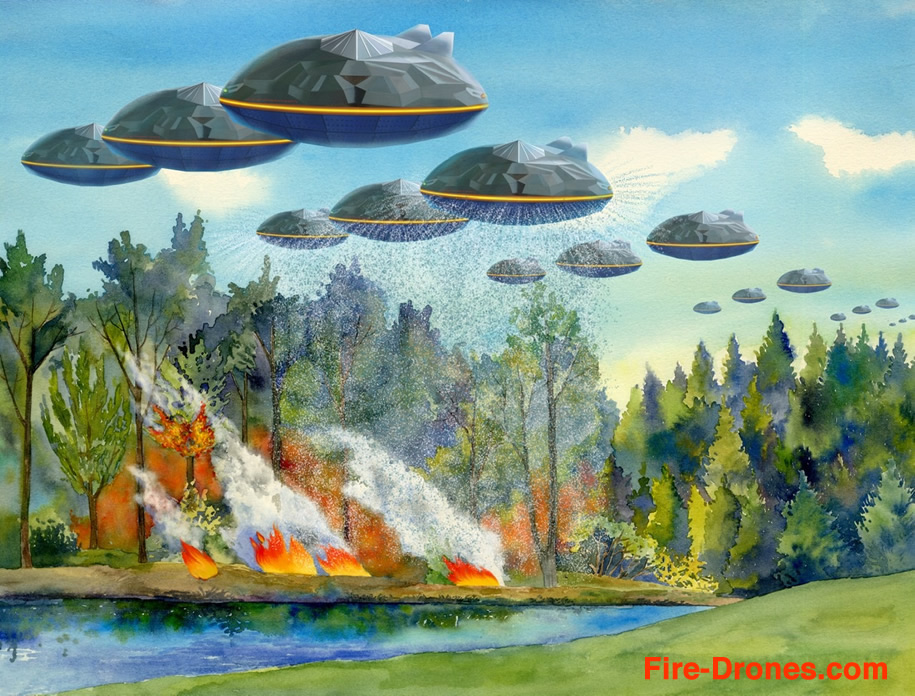
"Forests Can Breathe Again." • Vitaliia Kalmutska - Project Artist
|
|
FireDrones form a
feasible, timely, and scalable system
to
mitigate wildfires anywhere on earth.
Here are the key concepts.
|
|
|
Why do we need a new technology to control wildfires?
Our climate is warming each year, and to a greater degree than scientists predicted. BLOOMBERG The wildfire season in both hemispheres is longer than ever. The sheer intensity of wildfires and their expanding geographical extent grow larger each year — with no pause in sight. Next year will be hotter, and the year after that, hotter still.
The cost of the current firefighting system has grown precipitously, at the same time as its ability to control wildfires has diminished. US NEWS
The cost is stunning — in terms of personnel, equipment, and aircraft, the destruction of forests and their flora and fauna, the ravaged homes our fellow citizens must flee at a moment's notice, and the despair, helplessness and fear of what a warming future has in store for us.
What are FireDrones? Why are they better in the short run than current methods? How feasible are they?
FireDrones form a powerful state-of-the-art airborne water delivery system. Their purpose is to arrive on scene faster than ever before, at speeds of 180 MPH, and deliver a hard rain that won't stop until the fire is put out. When needed, specialized FireDrones will drop fire retardant chemicals, which are designed to stop chemical reactions in a fire.
This method will outstrip current forest fire fighting methods with speed and unending water capacity — and fire retardants where indicated. They will perform their crucial task over any terrain, in any weather or air temperature, and at any distance from the FireDrone base station.
No humans will be put at risk, and no ground-based attack is required.
A serious investigation by private enterprise and government agencies could determine the feasibility of this plan. The U.S. military and NASA could be part of the equation. They operate sophisticated drones, and their expertise in all facets of design and operation could be crucial.
Why are FireDrones effective in the long run?
All FireDrones will be exactly alike. This will allow for world-wide production centered on one basic platform. Efficiencies of a global mass production scale, and the utilization of universal code updates and physical platform enhancements will insure robust FireDrone production. They continuously evolve in sophistication at the job they are tasked to do. They are not temporary, nor a stop-gap. They are an ongoing solution to both wildfires and the greenhouse gases (CHG) they emit. FireDrone armadas will reliably put an end to wildfires.
What makes FireDrones urgent and scalable?
A FireDrone system is realizable in that it will draw upon current technologies for its initial prototypes and first run units for the field.
They will incorporate the apex of our collective technical knowledge.
A FireDrone is simply a pilotless flying device designed to deliver an unlimited rain-like water drop wherever it might be needed. Hundreds of FireDrones launch within minutes of any confirmed wildfire, and arrive on scene fast, with a maximum arrival time of 20 minutes— up to a 50 mile radius from the FireDrone Base Station.
Urgency is driven by the failure of current systems to quell the new larger and more pervasive firestorms, and the alarming predictions of a rapidly and dangerously warming atmosphere. SCIENCE NEWS
As nations accept the value of this system — juxtaposed against the existential threat at our doorstep — they can invest in it, and support the financial, scientific and moral context for its rapid deployment.
What can you do to support this initiative?
Getting this off the tarmac will require a groundswell of public interest and support. You can share this presentation with the people in your circle. You can make this a conversation piece at gatherings. You can email your elected representatives and ask them to launch preliminary studies and to commit to working prototypes. |
|
|
|
FireDrones
have one major goal: to extinguish a fire fast.

What causes wildfires?
Most wildfires are caused by the carelessness of humans. Campfires and still-burning cigarettes tossed into a dry patch of brush have ignited blazes that have scorched thousands of acres.
Lightning strikes, volcanic eruptions, spontaneous combustion, rocks striking each other as they roll down a hill, arson and old electrical transmission line fires are in the mix — the deadly and massive CampFire Blaze of Nov., 2018 in California started this way.
WILDFIRE MANAGEMENT INFORMATION (WFMI)
Out-of-control and massively destructive wildfires may become a distant memory.

This 8-page presentation is a mix of bold imagination and factual science.
We are intentionally speaking here about FireDrones as if they already existed, as if we know exactly what they will look like, and as if we know how fast and how far they can fly.
No FireDrones have yet been built.
What is being presented here is a clear and exhilarating vision of what might be possible.
Yet, consider that all the technology to design, build and field a robust and powerful global FireDrone system exists today.
What sets this presentation apart from other discussions of the Climate Emergency is that in addition to laying out the problem, we are also recommending solutions to the issues.
Proposing a daring new technology creates openings and possibilites that may never have been considered before. It gives us a place to stand that did not exist yesterday. It creates a space of permission for others to boldy dream.
There are many other brand new and exciting technologies being proposed on this website, as well as a call for a new TV/Radio/Online broadcast: The Climate Action Network.
If these proposals are realized, it will be due to their being deemed worthy. Should they not, at least they may inspire others to dream big and produce their own vision.
|
FireDrones — wave after wave — will saturate the burning forest below. No area in the fire zone will be missed and every area will sustain repeated and decisive treatment.
Each FireDrone will evenly and precisely deliver its payload of 3,000 lbs. of water (1361 kg, 360 US Gallons, 300 Imperial, 1.5 Tons), and does it not as a single water dump, but as a cool, widely distributed and saturating rain.
FireDrones will be designed to hover in the smoke — and defy the heat. They will be wherever needed for maximum effect.
This cascade of water from a never-ending skyborne flotilla will insure no mercy for the fire and its savage threat, no matter the ground area the fire has encompassed.
There are two game-changing principles that will give FireDrones their formidable power:
• |
They will attack and subdue the
fire while it is still in its infancy. |
• |
They will a form a continuous train of water delivery that never stops. |
 Hundreds will approach and arrive at the fire, and then they will circle back to base. Hundreds more will be launched — insuring a never ending hard rain. Hundreds will approach and arrive at the fire, and then they will circle back to base. Hundreds more will be launched — insuring a never ending hard rain.
The FireDrone sky-train will stop when sensors and base personnel deem the job done, the fire put out, and the threat neutralized.
The season, time of day, terrain, wind speed, altitude, distance, ground accessibility, weather, or air temperature will never be an impediment to completing their vital mission.
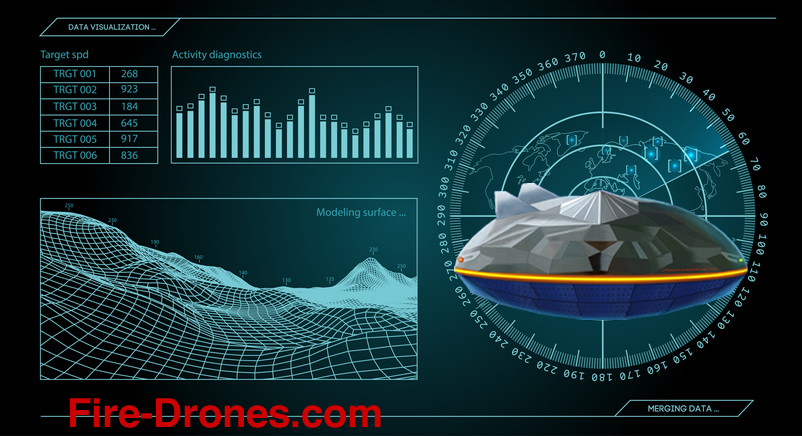
What if more 'FirePower' is needed?
If the initial assessment of 375 FireDrones proves insufficient, more units will be called into service from the originating base — and the next closest inactive bases if necessary.
The number of FireDrones allocated to any mission will also depend upon the distance to the fire. The further the distance, the more that will be required. Even at 180 MPH, the further the fleet must travel will also provide more precious time for the wildfire to spread.
Take a peek at a similar technology now being actively deployed. SCIENCEMAG |
|
|
|
50 miles from FireDrone Base Delta 9,
FireDrones
refill their water tanks on Lake Irene.
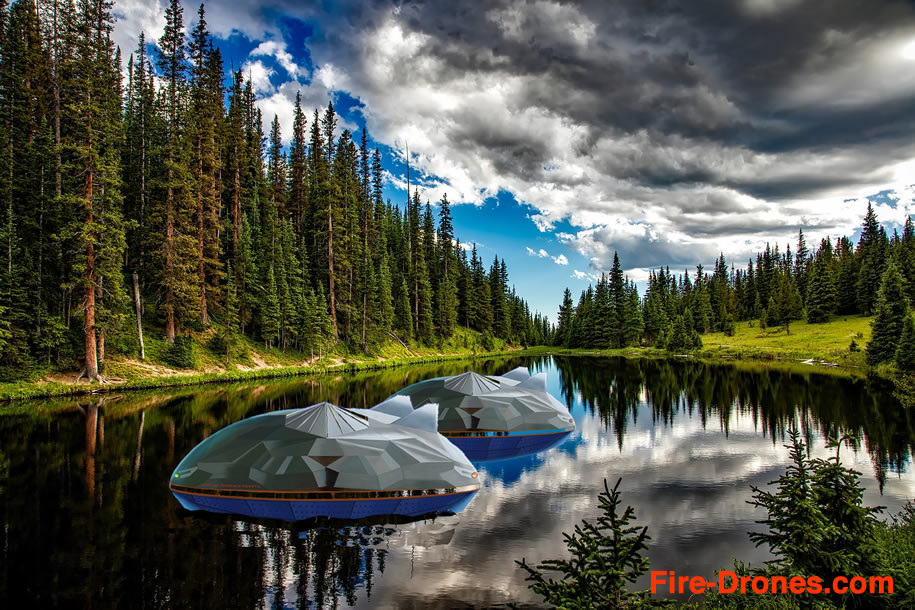 "FireDrones Sip Clear Water." • Vitaliia Kalmutska - Project Artist
"FireDrones Sip Clear Water." • Vitaliia Kalmutska - Project Artist |
|
A special-purpose group of 10 SafeDrones...
|
...will remain behind to scour every patch of smoldering ground below, while the rest of the FireDrone armada returns to base.
Our commitment is to make sure the sensors detect no hotspots above 120ºF / 49ºC.
Small flare-ups that might arise will be extinguished within minutes.
Not until every patch of ground is safe will the SafeDrone squad return to base. |
|
|
|
Consider this miracle of human innovation.
|
|
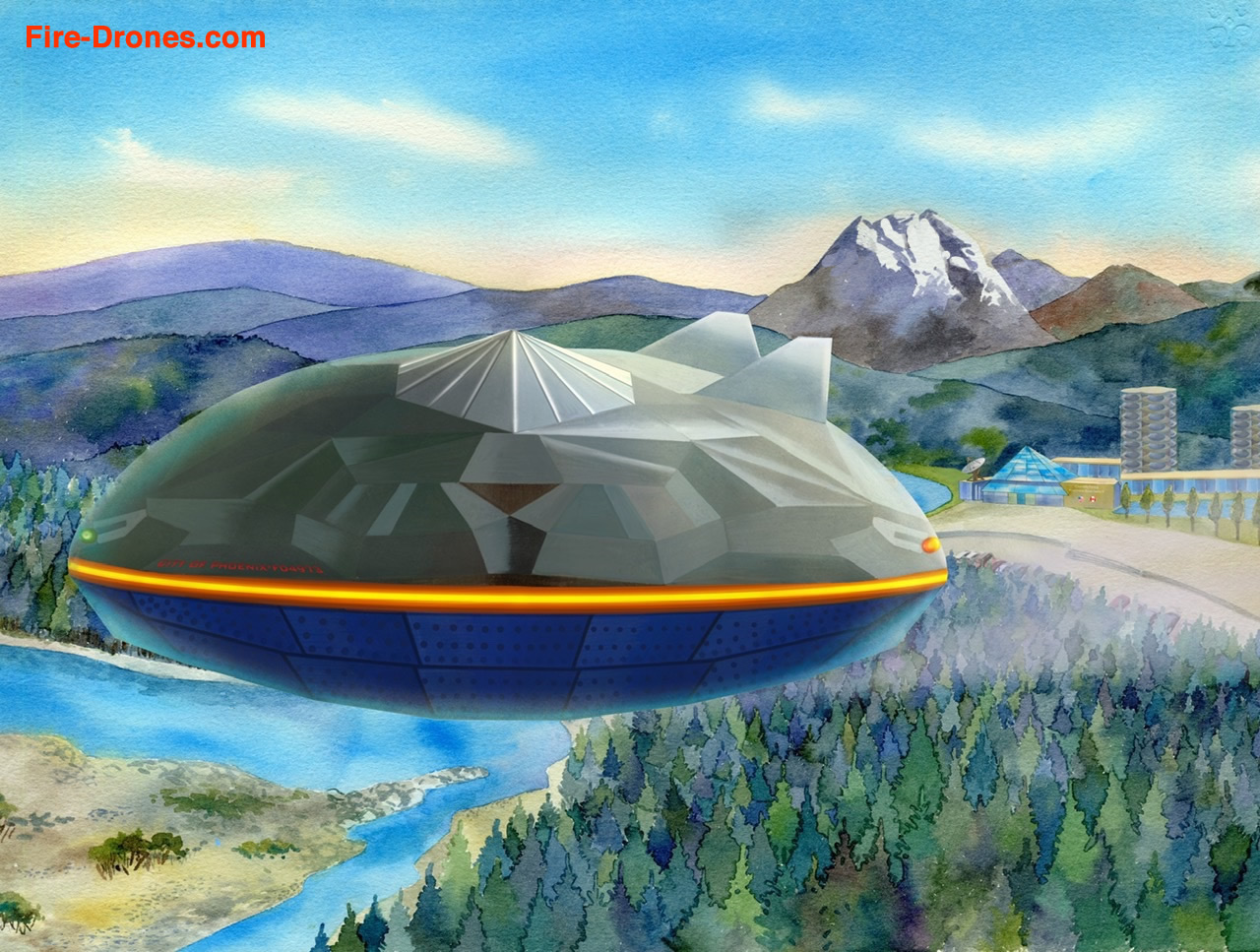 "FireDrones Launch a New Era." • Vitaliia Kalmutska - Project Artist
"FireDrones Launch a New Era." • Vitaliia Kalmutska - Project Artist |
|
Impenetrable forest, steep terrain, roadless valleys...
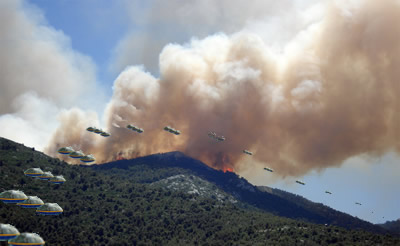
Image by Saiho from Pixabay • FireDrone fleet added to the image.
Remote fires haven't got a chance.
FireDrones will not require human pilots — neither on-board nor remotely stationed.
This will allow for their instantaneous deployment to scale, wherever they are needed, without time-wasting preparation.
Conceive of FireDrones as robust flying tanks— in both senses of that word. Everything about their design and performance will intentionally be an invocation of the most advanced technology we can muster. They will be crafted to deliver results without excuses. They will outstrip any current drone design in terms of flight capability, power, range, and longevity.
|
...will no longer be a barrier to a precise, and massive attack on the spreading wildfire.
Neither fire breaks nor access roads will be needed to quell any wildfire.
________________________________
9,000 lbs. of water drops from the airborne fleet above this mountaintop wildfire every 30 seconds. The FireDrone wave is purposely continuous. It never stops until the last ember is cold.
________________________________
Lightning-strike fires in mountainous terrain or in remote areas will be easily contained.
Aerial water curtains will take the place of Hot Shot back fires where a backstop may be indicated, for example, a thousand yards in front of a fire driven by high winds.
FireDrones will be ready to battle wildfires whether in a forest, a peat and tundra environment, or on a distant prairie.
Anywhere a wildfire appears, it will meet its watery end fast. |
|
|
|
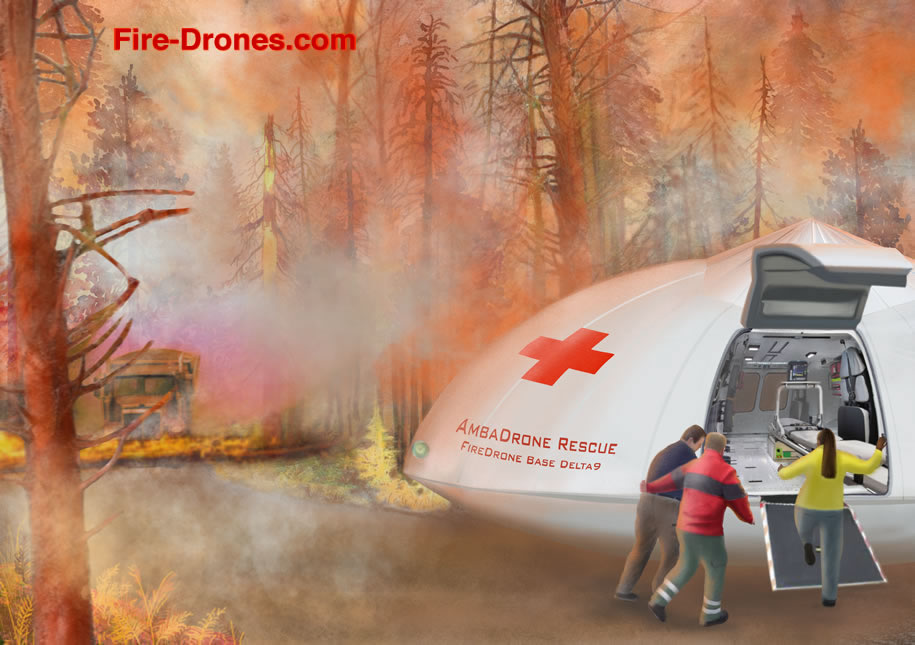 "Rescue Came When Needed Most." • Vitaliia Kalmutska - Project Artist
"Rescue Came When Needed Most." • Vitaliia Kalmutska - Project Artist |
|
AmbaDrones accompany all missions...
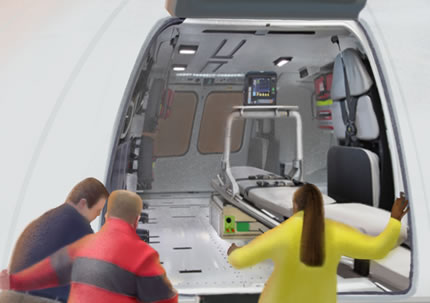
A medically equipped flying ambulance — an AmbaDrone — whisks people trapped
in a raging wildfire to safety.
Emergency room quality first aid is administered in flight if necessary.
|
...and they are a welcome sight for people trapped in the inferno.
They are lightweight, carry little water, and their engines' requirements also reduce weight, for the same reason.
First responder medical personnel travel in the AmbaDrone along with the fleet— if it is thought there is even the smallest chance any people are in trouble on the scene.
Where human personnel are not indicated, a few AmbaDrones still arrive at all fires. They can navigate through the burning forest, through the smoke and heat, and identify anyone on scene who may be in trouble.
They will then be whisked back to Base — which maintains a fully equipped and professionally staffed emergency unit — or to the closest medical facility without waiting for the fleet to finish their mission. |
|
|
|
Neighborhoods adjacent to forests...
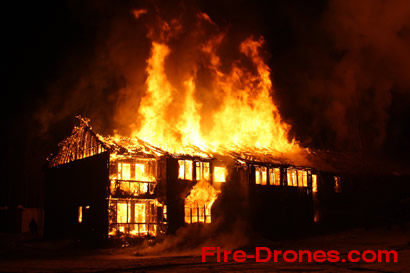
The FireDrone model
is intentionally designed to overwhelm any fire's power.
The paradigm shift rests on this commitment:
| |
For every wildfire and inhabited area in danger, airborne water will be deployed as is needed to subdue the fire before it spreads and extinguish it within two hours of the first spark. |
That relief will arrive anywhere at any time of the day or night, in any season, and under any conditions of heat or wind, and in any terrain.

Prairie fires can stretch over a broad front, and race at high speeds. FireDrones can match any speed, fly day or night, cover the entire front, and have hundreds of units positioned both in front and behind of the advancing flames.
With FireDrones attacking wildfires by the hundreds, that for which our technology previously had no answer will now be a challenge which can be quelled and defeated.
Bear in mind that many grassland and prairie fires are beneficial and necessary, and are part of a natural cycle. In general, fire is used as an appropriate management tool for a variety of ecologically correct purposes. NATURE
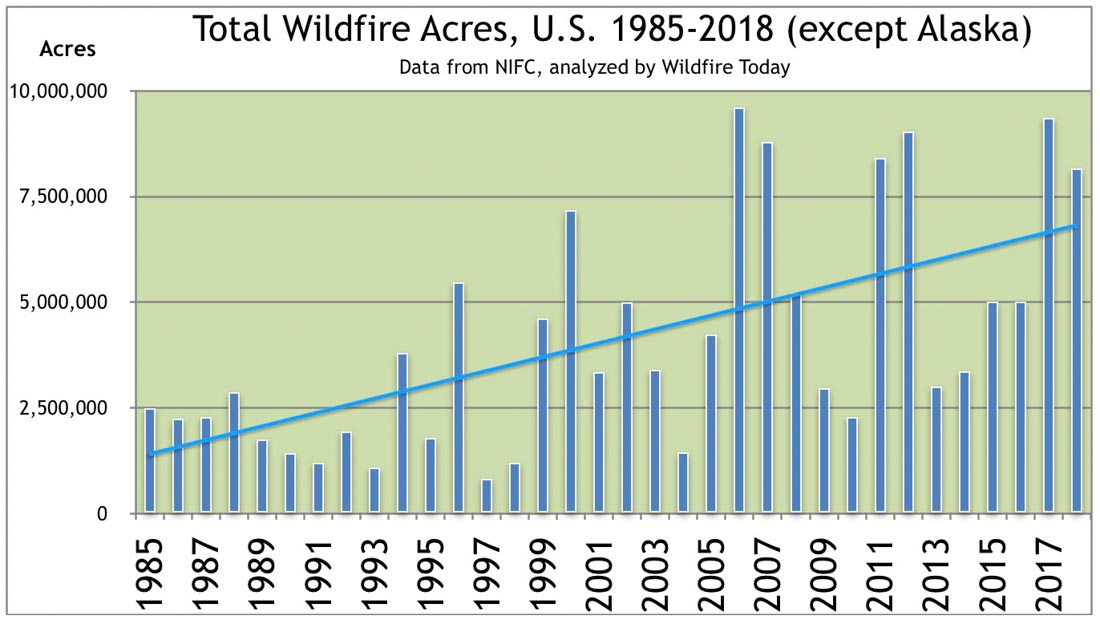
Total Wildfire Acres, US (except Alaska.) Left side header: Acres
(US) NATIONAL INTERAGENCY FIRE CENTER - NIFC
2018 saw 8.8 million acres burned. In 2020, at minimum, 9,305,160 acres went up in flames.
(US) NATIONAL INTERAGENCY FIRE CENTER - NIFC
|
...deserve special protection.
Even the smallest of newly identified wildfires will receive larger armadas of FireDrones when they are near to homes or other structures of our civilization.
We can't wait until a housing subdivision or town catches fire before dousing adjacent forested areas not yet on fire. Job #1 is to generously and continuously inundate the arboreal periphery of any inhabited zones.
At the same time, all homes and residential neighborhoods receive protection with a
preemptive FireDrone rain directly on these otherwise vulnerable structures.
Hundreds of FireDrones mass, hover in place, and remain on duty as any fire may be approching. As they expend their watery payload, fresh FireDrones replace them.
The goal is to neutralize any flying cinder, and counteract any advancing threat.
_____________________________________
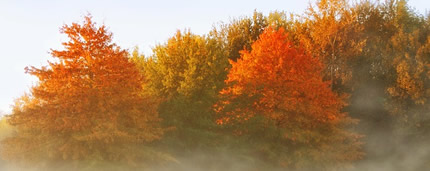
Image by Andrea Stöckel-Kowall from Pixabay
Maples, Oaks, Birches and other deciduous trees face being displaced.
As anthropogenic (human caused) CO2 increases in the atmosphere, evergreen trees are more adaptable than deciduous trees, and begin to supplant them, reducing their range.
SCIENCE MAGAZINE / DISCOVER MAGAZINE
Deciduous trees are those that seasonally shed their leaves in autumn, and sprout new leaves in spring, as opposed to evergreens — such as pines and spruces — which stay green year-round. Deciduous trees decrease wildfire activity compared to evergreens.
NASA
With the ever-greater extent and longer season for wildfires, those trees burn. Deciduous trees are already disappearing from drier regions, and 'invading high northern altitudes once covered by coniferous boreal forests.' Quoted content: SEATTLE Pi
|
|
|
|
Vast tracts of peat and tundra are burning.
FireDrones might stop that cold and prevent new outbreaks.
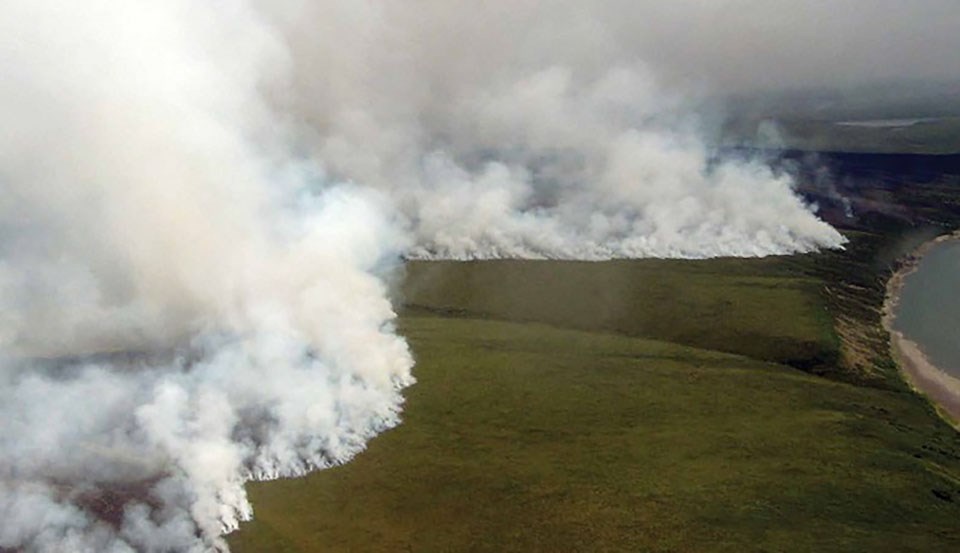
The increase in the number and scope of peat and tundra fires and the gargantuan amounts of CO2 and methane they are releasing cries out for a solution: FireDrones could do the job.
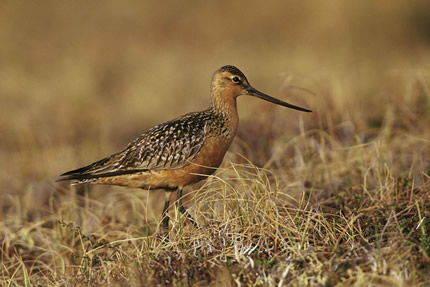
An imperiled dweller of the tundra.
"Peat fires are important because they burn carbon that was sequestered over 1000's of years. Unlike a grass/forest fire, emissions cannot be treated as carbon neutral.
Once ignited, peat burns for a long time and is difficult to extinguish.
Peat fires are part of a climate system positive feedback loop. Higher Arctic temperatures increase the likelihood of peat ignitions during a fire, as the extra heat dries the (normally moist) peat out.
Warm air from tropical regions heads north and south. When it meets the cool air mediated by the northern tundra and southern Antarctica, it cools and returns to the equator, keeping the planet in balance.
Without this natural system, the earth would become unbearably hotter.
Resultant greenhouse gas emissions will only lead to more heating." TWITTER
Dr. Thomas Smith, London School of Economics and Political Science
Tundra is a vital part of the global planetary cooling system. Tundra and peatlands sequester vast amounts of CO2— and that is a positive process we would want to continue.
A breakdown of this biomass may cause global temperatures to rise precipitously.
They are now and will continue to be a valuable CO2 capture resource if we can keep them from burning. We can do that by a global effort to reduce temperatures worldwide, and until we achieve that goal, by a complete mitigation of tundra and peat fires with a FireDrone umbrella.
_____________________________________
Keep up-to-date with regular Climate News from Henry Fountain • NY TIMES |
Located at latitudes 55° to 70° North, the tundra is a vast and treeless land which covers about 20% of the Earth's surface, circumnavigating the North pole. BLUE PLANET BIOMES
Like forest fires, peat and tundra fires have always been part of the natural course; study of the tundra reveals that fires have occurred seasonally in cycles, with greater and lesser frequency over the last 6,000 years.
Forests today have at least some resources committed to their protection; the vast tracts of peat and tundra have nothing comparable. FireDrone bases deployed to scale in those regions could alter that disastrous dynamic.
The consequences of out-of-control tundra fires are a daunting litany very similar to the troubles our forests are now experiencing.

Tundra covers 20% of the earth's surface. And that tundra and peat is now burning. Photo by Tomáš Malík on Unsplash
CO2 and methane (CH4) are in play in this scenario. Methane is a greenhouse gas that is 30 times more heat-trapping than CO2.
"The third most abundant compound in peat fire emissions is methane. CH4 from peat fires are approximately two times higher than those for tropical forest fires, and are almost six times higher than savanna fire."
INTERNATIONAL JOURNAL OF WILDLAND FIRE
Hundreds of well-equipped FireDrone bases can be positioned throughout the Arctic tundra and peat mound regions of Alaska, Canada, Greenland, Iceland, Russia and Scandinavia.
In addition to those areas, peat fires not in the tundra take place on six continents.
Waves of FireDrones can terminate any new tundra fire as soon as it begins, and can spend much of their non-emergency time slowly but surely extinguishing every other ongoing peat and tundra fire in progress anywhere in the world they might be.
Rather than merely recite the litany of climate horrors in progress or about to crash land on our ordinary daily lives, let's instead act with purpose and alacrity to reverse each and every instance of them. Let's publicize them, and let's implement the dynamic principles of Scale, Spend and Urgency as our contextual roadmap. |
|
|
|
Every city Fire Department can put FireDrones to good use.
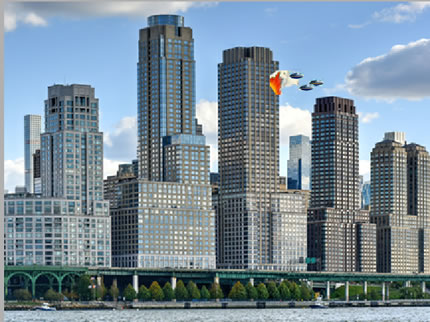
FireDrones targeting a fire
on the 52nd Floor with a stream
of precisely targeted water.
"Stop a fire while it's still small."
|
There are more than 15,000 tall structure fires each year in the US alone. They affect skyscrapers, hotels, apartment buildings, hospitals, dormitories — or any tall buildings.
The vast majority of those fires are handled and subdued by fire resistive construction design, on-site fire protection equipment and the timely arrival of Fire Dept. personnel.
High-rise fires that are not controlled can spread quickly. They are difficult to address if they are out of the reach of conventional ground-based fire fighting methods.
FireDrones — stationed on rooftops throughout the city — arrive in minutes of an alarm. They blast water directly into the fire at any altitude — and prevent the building from becoming engulfed in flames. |
|
|
|
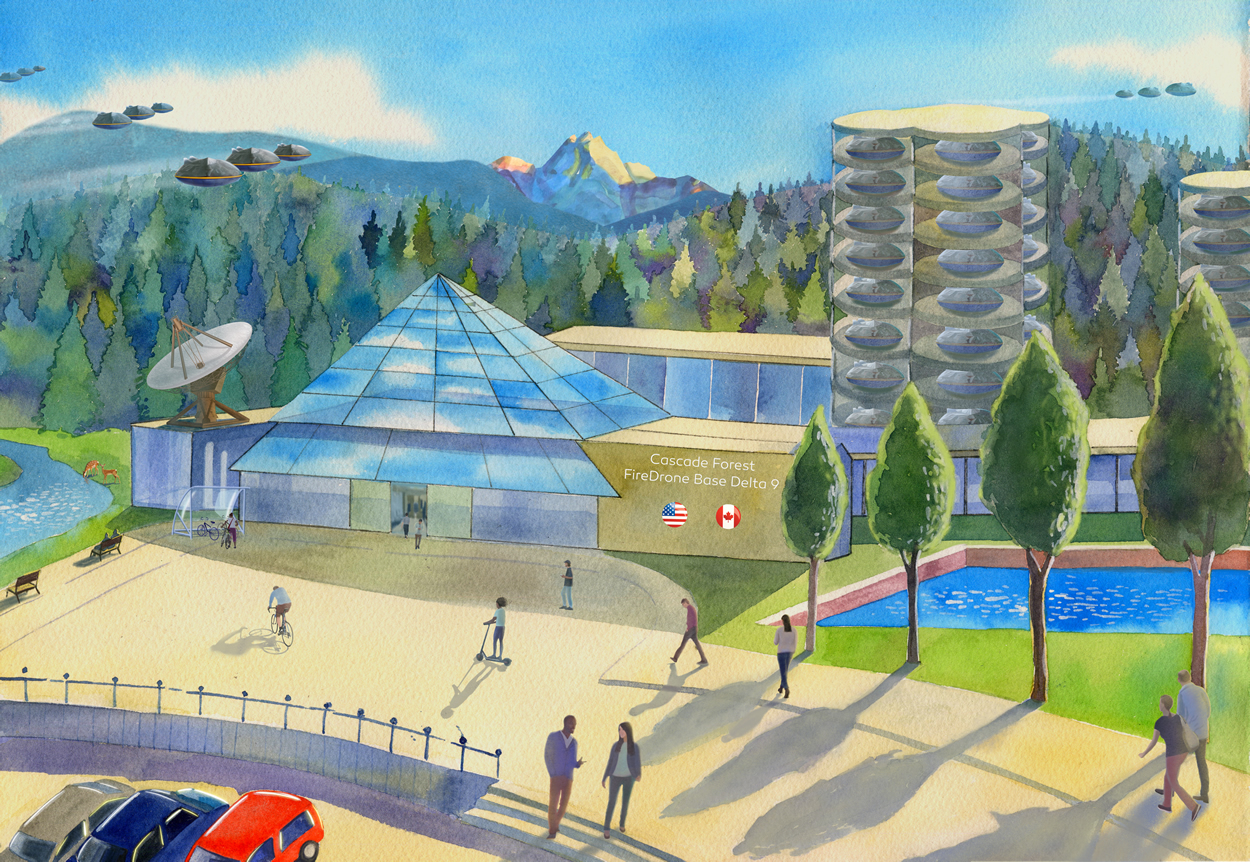 "A Noble Purpose Achieved." • Vitaliia Kalmutska - Project Artist
Welcome home! The FireDrone expedition is returning to base.
"A Noble Purpose Achieved." • Vitaliia Kalmutska - Project Artist
Welcome home! The FireDrone expedition is returning to base.
| The group has effectively put out the wildfire in an otherwise inaccessible canyon 60 miles away.
As the group re-enters the space of base operations, its descent slows to a foot a second. Each FireDrone returns to its hangar for inspection, refueling and any maintenance that might be required. |
|
|
FireDrone bases are a 24/7/365 operation.
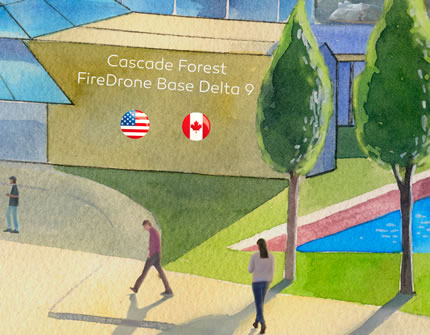
Cascade Forest - FireDrone Base Delta 9
|
This modern, state-of-the-art Canada / United States FireDrone base is located right on the border, and serves an 80 mile radius.
FireDrone base operations around the world utilize the same standardized technology; strategically located engineering facilities on six continents are constantly upgrading the advanced onboard and base control technologies to drive maximal performance.
Schoolchildren are particularly interested in visiting the base, and they are welcomed with FireDrone balloons, an exciting tour of the facilities, and a healthy lunch. |
|
|
|
FireDrone bases are positioned throughout North America...
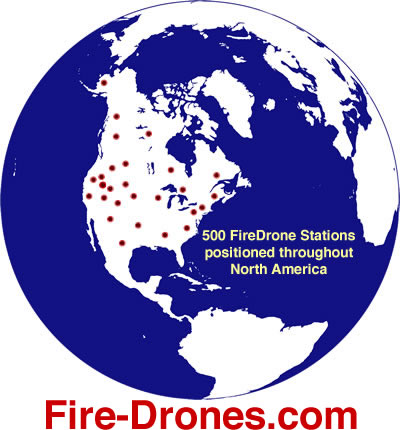
500 FireDrone Stations positioned throughout North America
|
...and around the world. They are concentrated in areas of highest danger, and most susceptible to ignition from a warming atmosphere. Standardization of FireDrones, bases and methods promotes a rapid global deployment of technology and infrastructure.
The number of FireDrone bases in the
US and Canada might be about 500. Bases will have hundreds of FireDrones ready to launch at a moment's notice. Stations will be busy, organized, efficient and ready.
Just as several fire-fighting companies in a big city might be called to a blaze, so too will many bases contribute when needed to put out any and all fires near them. |
|
|
|
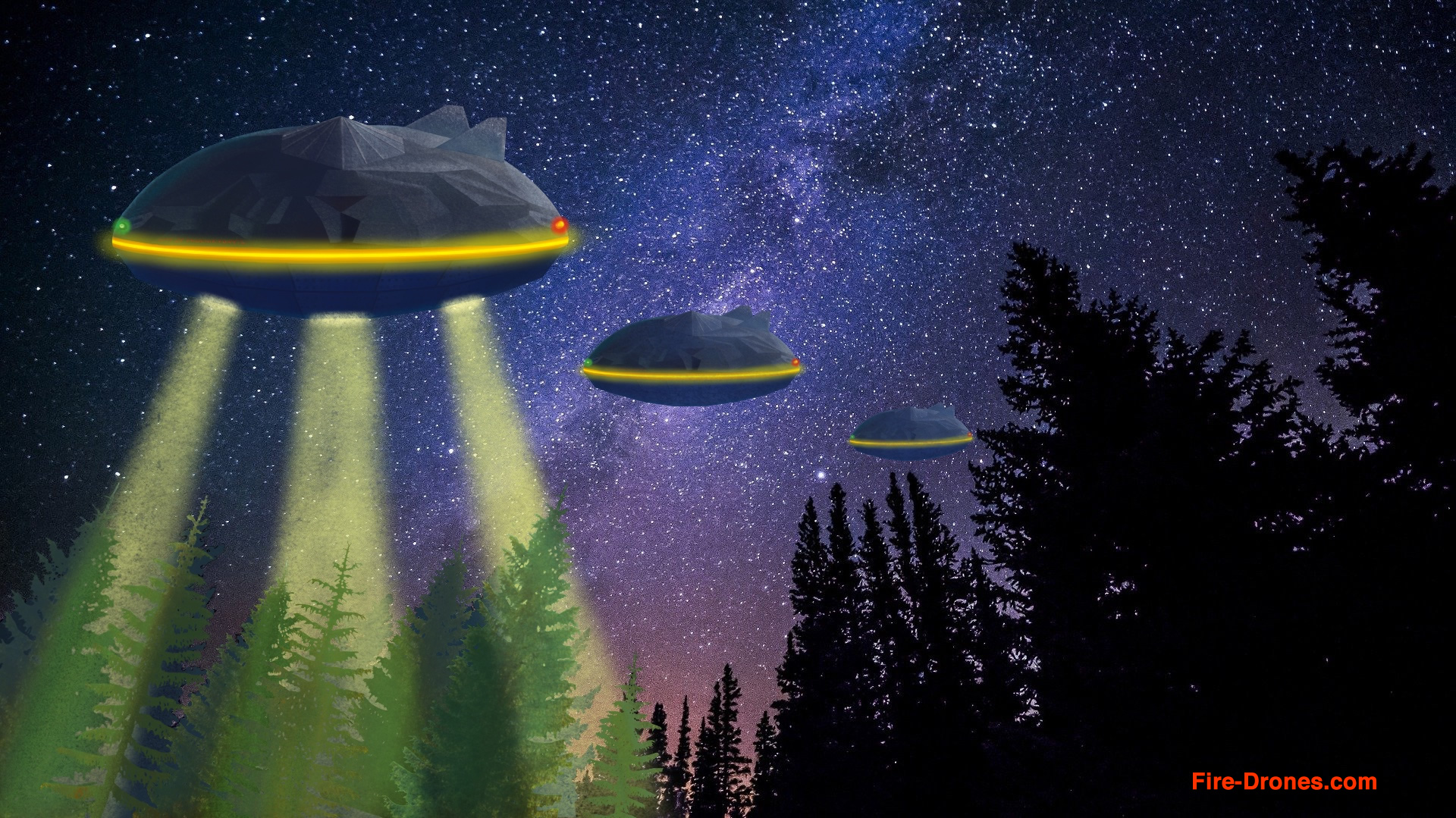
"Pure Light From Above." • Vitaliia Kalmutska - Project Artist
Bright SkyBeams illuminate the burning forest below at night or in day-dark smoke allowing the staff at FireDrone Base Delta Nine to see what's happening. A composite of the area
is imaged by powerful supercomputers. Conditions on the ground are clear and action is appropriate.
Bright, sharp and penetrating light also aids the escape of any people caught in the fire zone — or supports their rescue by AmbaDrones — with the careful guidance of Base Station staff.
Day or night, lost hikers with the ability to phone an emergency, or who family members say are missing, receive the support of search and rescue AmbaDrones even when no fire is present. |
|
|
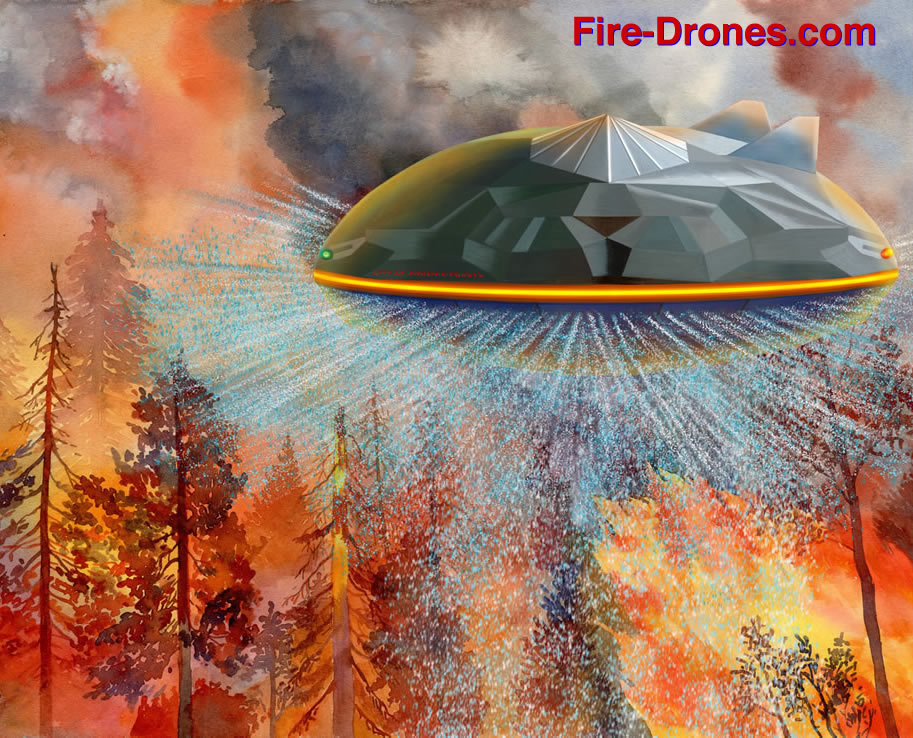 "When There Was None— Rain Appeared." • Vitaliia Kalmutska - Project Artist
"When There Was None— Rain Appeared." • Vitaliia Kalmutska - Project Artist |
|
A commitment landed humans on the moon over 50 years ago.
|
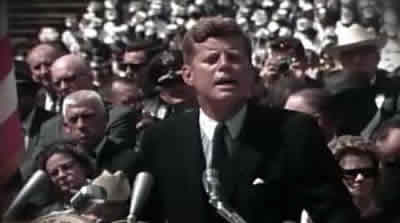
"We choose to go to the Moon in this decade and do the other things,
not because they are easy, but because they are hard;
because that goal will serve to organize and measure the best
of our energies and skills, because that challenge is one
that we are willing to accept, one we are unwilling to postpone,
and one we intend to win, and the others, too."
President John F. Kennedy • Sept. 12th, 1962 |
John F. Kennedy's inspirational goal was achieved in a mere 7 years. Unlike the untested and yet to be invented technologies of 1962, all of the state-of-the-art scientific and engineering prowess to craft potent FireDrones exists today.
Drone technology is advancing at a prodigious rate — yet no country has focused this formidable capability on rendering unwanted forest fires ancient history. That time has arrived, and a coalition of willing nations might lead the charge. |
|
|
|
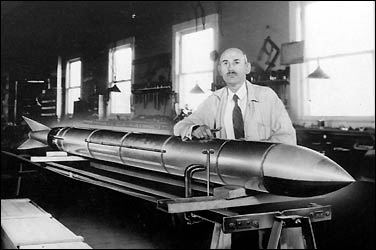
"Every vision is a joke until
the first person
accomplishes it;
once realized, it becomes commonplace.”
Robert Goddard - Inventor of the modern rocket.
|
|
|
Danger and Opportunity
|
The main purpose of this presentation is to showcase several novel concepts of what large scale plans to reverse Global Warming might
look like. For example, this page introduced you to the power and potential of FireDrones. |
A secondary purpose is to provide an overview of information about selected serious challenges we face as a result of the Climate Emergency.
It is not meant to be a comprehensive encyclopedia of all or even most of the existential dangers our civilization confronts. |
A third purpose is to address the emotional barriers to our taking action, individually and as a society.
How can we surmount that debilitating sense of feeling helpless and powerless in the face of a seemingly unstoppable climate meltdown? |
 This presentation is conceived, written and produced by Warren Selinger. The ideas presented are designed to stimulate public and scientific conversation regarding practical methods to reverse global warming quickly. You are invited to build on the possibilities. This presentation is conceived, written and produced by Warren Selinger. The ideas presented are designed to stimulate public and scientific conversation regarding practical methods to reverse global warming quickly. You are invited to build on the possibilities.
Yes, even though there are only eight of them, these are long scrolling pages, and each one is more like a chapter than a page. Pace yourself to receive the greatest benefit. |
|
|
Together we can make this just a memory.
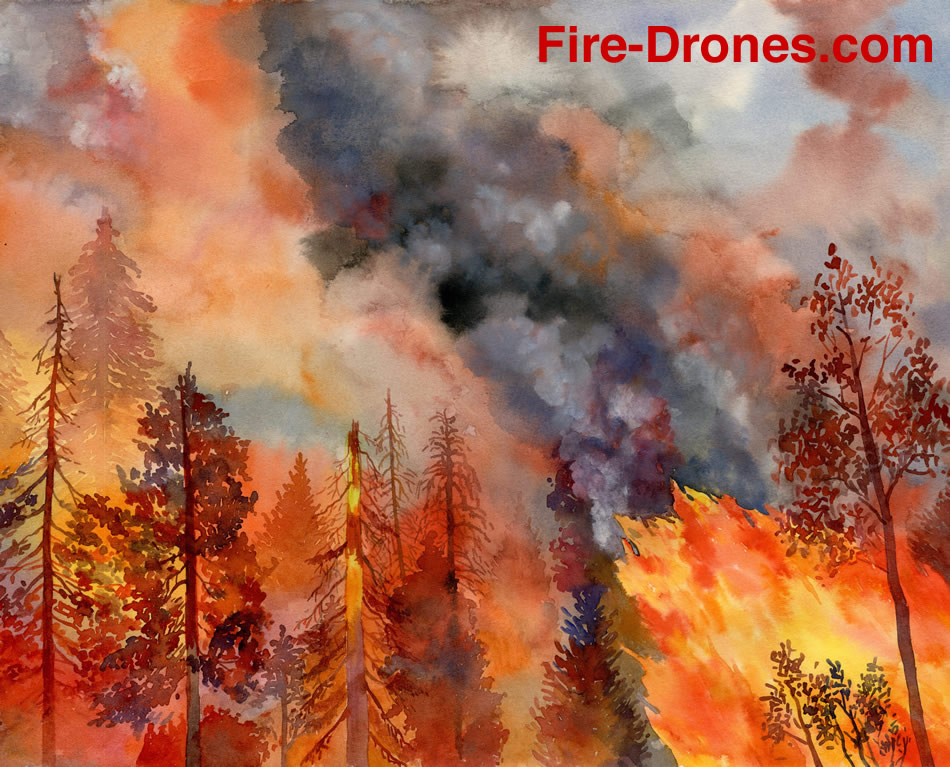 "The Last Wildfire." • Vitaliia Kalmutska - Project Artist
"The Last Wildfire." • Vitaliia Kalmutska - Project Artist
|
|
Quotes • "Only an acceptance of responsibility."
"The path we are on as a planet should terrify anyone living on it, but, if we think like one people, all the relevant inputs are within our control and there is no mysticism required to interpret or command the fate of the earth. Only an acceptance of responsibility."
- David Wallace-Wells
"..it’s all about sending a signal that we are in a crisis and that in a crisis you change behavior. If no one breaks this chain of 'I won’t do this, because no one else is doing anything' and 'Look at them. They’re doing much worse than I am' — if everyone keeps on going like that, then no one will change.
We don’t understand that we are in a crisis. If people don’t understand that we are in a crisis, they won’t put pressure on people in power. If there’s no pressure on people in power, then they can continue to get away with doing basically nothing.
But if you fully understand the science, then you know what you as an individual have to do. You know then that you have a responsibility."
– Greta Thunberg
"Climate change is a global crisis - one the international community and private sector must tackle together if we have any hope of averting the worst impacts on our health, our economies, and our communities."
- Tom Steyer
“Some people see things as they are and say why? I dream things that never were and say, why not?”
– Robert Kennedy
"You may say I'm a dreamer...
but I'm not the only one."
- John Lennon
"That which hath made them drunk hath made me bold. What hath quenched them hath given me fire." Lady Macbeth
- William Shakespeare
"We are only trustees for those who come after us."
- William Morris
"Keep calm — and carry on."
- Winston Churchill
To be sure, carry on with the implementation of bold and timely Climate Emergency solutions at scales that unfailingly reverse the crisis.
|
|
"We must recognize that our lives will no longer unfold on a stable planet. We must see that we are not separate from the natural world but our lives — today and tomorrow — are totally dependent on a steady climate and civilization: If the oceans die, we die. If the forests die, we die."
- Margaret Klein Salamon
“If you believe that astronauts have been to the moon and that the world is not flat, then you probably believe the satellite photos showing the Greenland ice sheet in full-on meltdown.
Much of Manhattan and the Eastern Shore of Maryland may join the Atlantic Ocean in our lifetimes. Entire Pacific island nations will disappear. Hurricanes will bring untold destruction. Rising sea levels and crippling droughts will decimate crops and cause widespread famine. People will go hungry, and people will die.”
- Bill McKibben
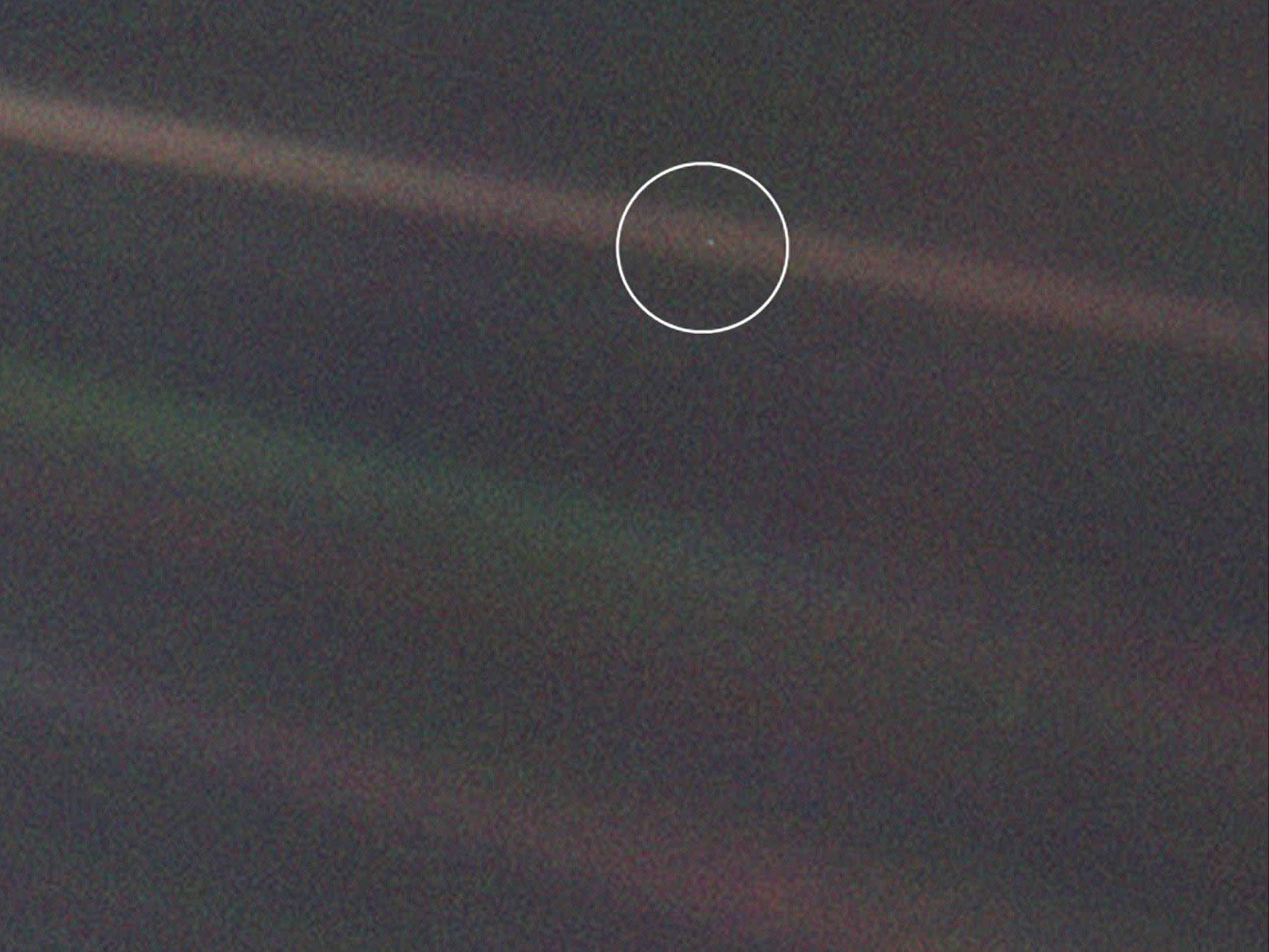
NASA
“You see that pale, blue dot? That's us. Everything that has ever happened in all of human history, has happened on that pixel. All the triumphs and all the tragedies, all the wars, all the famines, all the major advances... it's our only home.
And that is what is at stake, our ability to live on planet Earth, to have a future as a civilization. I believe this is a moral issue, it is your time to seize this issue, it is our time to rise again to secure our future.”
- Al Gore
Images on this site without attribution are mostly sourced from the superb collection of climate-related photos at istockphoto.com
Special thanks to the tireless efforts of the gang of astute advisors and contributors who guided, corrected, debated and polished this work.
You know who you are. |
|
 |
|
Special thanks to Vitaliia Kalmutska, our project artist for many of the larger-scale works of artful science showcased in this ground-breaking Climate Emergency presentation.
Her ability to take a rough hand-scribbled drawing and turn it into art that is both lyrical and compelling is extraordinary. Please consider Vitaliia should you have art requirements. |
Do you have questions about what's being presented here?
Do you have suggestions for improving the climate amelioration possibilities showcased?
Click on Questions & Suggestions > |
|
|
|
There's a lot more here for you to discover.
Please go on to the next page... |
|
|
|
|
|
 |